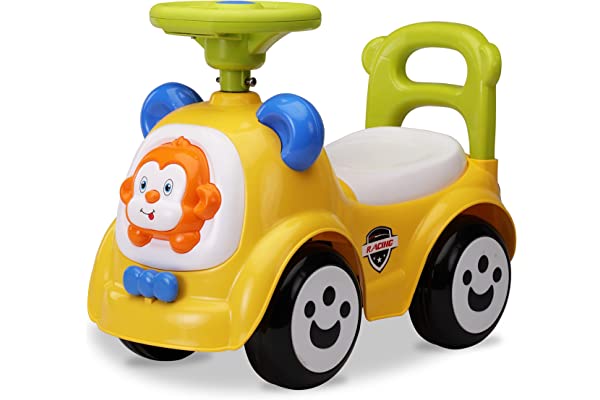Ride-on toys are incredibly popular among children of all ages and can offer hours of fun. However, parents must be aware that these toys come with potential risks and dangers if they are not properly manufactured and maintained. To ensure a safe ride for your child, it is important to look for certain safety features in any ride-on toy you purchase. This article will discuss 25 safety features every ride-on toy should have to guarantee a safe experience for both the rider and any bystanders. Read on to learn more about what makes a ride-on toy safe!
1. Foot Placement: The foot placement of a ride-on toy should be secure and easy to get into. This prevents riders from slipping off the toy while in motion, which could lead to an accident.
2. Seatbelts: Every ride-on toy should have a seatbelt that can securely fasten around the waist or chest of the rider. This will keep them firmly in place and prevent them from being thrown off their vehicle in case of an unexpected jolt or bump.
3. Roll Bars: Many ride-on toys, especially those designed for younger children, come with roll bars attached to the frame. These provide extra protection if the vehicle flips over during use and can help minimize injury risk during such an event.
4. Brakes: All ride-on toys should come with brakes that the rider can easily operate. This will allow them to stop quickly if necessary and minimize the risk of crashing into something or someone else.
5. Lights: Some ride-on toys may be equipped with headlights, taillights, or turn signals. These are especially important for those who plan on riding their toy in low-light conditions, as they make it easier for other drivers to spot you on the road.
6. Horns: A horn is a great way to alert others of your presence while riding your toy, which can help avoid collisions or accidents with pedestrians and vehicles alike.
7. Mirrors: Mirrors can help riders see what’s behind them, increasing their awareness of their surroundings and reducing the risk of an accident with another vehicle or pedestrian.
8. Battery Safety: Electric ride-on toys must be equipped with a secure battery cover that won’t come loose during use. This prevents young children from coming into contact with potentially hazardous electrical components and reduces the risk of injury.
9. Fire-Resistant Materials: All materials used in the construction of a ride-on toy should be highly fire-resistant, as this can reduce the risk of a catastrophic accident in an unexpected fire.
10. Warning Symbols: All toys should display warning symbols to alert riders and bystanders of potential hazards, such as electric shocks or collisions, to their use.
11. Handlebars: All ride-on toys should come with handlebars that are easy to grip and securely attached to the frame. This makes it easier for riders to maintain control of their vehicle while in motion.
12. Fenders: Fenders act as guards against dirt, mud, and other elements from splashing onto the rider or bystanders. This is especially important for electric ride-on toys, as water can cause shorts in the electrical components and create a serious hazard.
13. Footrests: Footrests keep riders’ feet firmly planted on the toy while driving, reducing the risk of slipping off and causing an accident during operation.
14. Safety Instructions: Any ride-on toy should come with clear and easy-to-understand safety instructions that explain how it should be used. This can help ensure riders know all the safety considerations associated with driving their toy and reduce the risk of an accident.
15. Age Ratings: Ride-on toys should have age ratings, so parents know which toys are appropriate for their children’s age group.
16. Weight Limits: Most ride-on toys will have a maximum weight limit indicated somewhere on the packaging or in the manual, which is important to adhere to as this will significantly reduce the risk of tipping over or having inadequate braking power while in motion.
17. Lockable Steering Wheel: Many ride-on toys come equipped with lockable steering wheels, which can help prevent young children from taking the toy out without adult supervision.
18. Seat Belts: Seat belts are an essential safety feature on all ride-on toys, as they keep riders securely in place while they’re driving and reduce the risk of injury in case of a sudden stop or crash.
19. Protective Gear: Protective gear such as helmets and elbow/knee pads should be worn by all riders of ride-on toys to protect them if an accident does occur.
20. Speed Limiters: Most ride-on toys will come equipped with speed limiters that can be adjusted according to the rider’s experience level or age group, reducing the risk of an accident due to excessive speed.
21. Brake Lights: Many ride-on toys are now designed with functioning brake lights to alert other drivers or pedestrians of the toy’s sudden changes in speed or direction.
22. Headlights: Headlights can help riders see better while driving their toy at night, reducing the risk of running into something during low visibility conditions.
23. Tail Lights: Like brake lights, tail lights on a ride-on toy will alert nearby drivers and pedestrians of its presence when braking, helping to prevent accidents caused by sudden deceleration.
24. Turn Signals: Most electric ride-on toys will come equipped with functioning turn signals so that other drivers can easily see which direction the toy will turn, helping to prevent collisions.
25. Mirrors: Rearview mirrors can help riders maintain awareness of their surroundings and reduce the risk of an accident due to limited visibility.
Ride-on toys should have several safety features that help keep riders safe and reduce the risk of an accident. These include handlebars, fenders, footrests, safety instructions, age ratings, weight limits, lockable steering wheels, seat belts, protective gear, speed limiters, brake lights, headlights, tail lights, turn signals, and mirrors. When selecting a ride-on toy for your child or loved one, it is important to ensure all of these features are present and that they meet any age requirements specified on the packaging. By doing so, you can ensure a safe and enjoyable experience for everyone who will be using the toy.


























